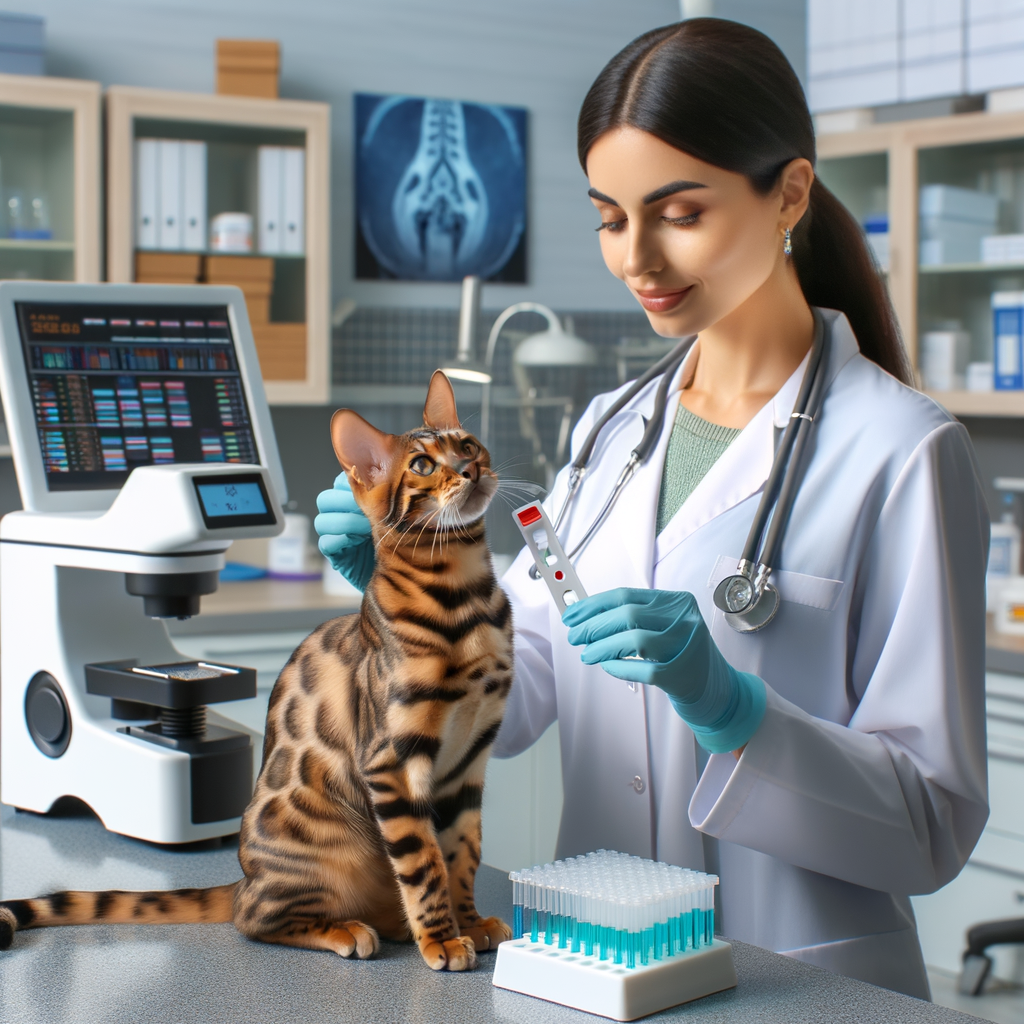
Introduction to Bengal Cat Genetics
-
Understanding the basics of Bengal cat genetics:
Bengal cats are a unique breed known for their striking appearance and playful nature. Their genetics play a crucial role in their distinctive traits. Bengal cats are a hybrid breed, created by crossing domestic cats with the Asian leopard cat. This mix gives them their wild look and energetic personality.
-
How genetics influence Bengal cat health:
Just like humans, the health of Bengal cats is influenced by their genes. Certain genetic traits can make them more prone to specific health issues. For example, some Bengal cats may inherit a predisposition to heart disease or hip dysplasia. Understanding their genetic makeup can help in managing their health better.
Bengal Cat Health Issues and Genetics
Common Health Issues in Bengal Cats
- Overview of Bengal cat health issuesBengal cats are generally healthy, but they can have some health problems. Common issues include:
- Heart Disease: Bengals can suffer from hypertrophic cardiomyopathy (HCM), a condition where the heart muscle thickens.
- Joint Problems: Hip dysplasia and patellar luxation can affect their mobility.
- Eye Conditions: Progressive retinal atrophy (PRA) can lead to blindness.
- Digestive Issues: Bengals may have sensitive stomachs and food allergies.
-
Role of genetics in these health issues
Genetics play a big part in the health of Bengal cats. Some health problems are inherited from their parents. For example:
- Hypertrophic Cardiomyopathy (HCM): This heart disease is often passed down genetically.
- Progressive Retinal Atrophy (PRA): This eye condition is also inherited and can be detected through genetic testing.
Genetic Disorders in Bengal Cats
-
- Understanding Genetic Disorders in Bengal Cats
Genetic disorders are health problems that are passed down from parent cats to their kittens. These problems are caused by changes or mutations in the cat’s DNA. Bengal cats, like all breeds, can have genetic disorders. Knowing about these issues helps in keeping your Bengal cat healthy.
-
- Examples of Common Genetic Disorders
Here are some common genetic disorders found in Bengal cats:
-
-
- Hypertrophic Cardiomyopathy (HCM): This is a heart disease that makes the heart walls thick. It can lead to heart failure. Regular vet check-ups can help catch this early.
- Progressive Retinal Atrophy (PRA): This disorder affects the eyes and can lead to blindness. Test breeding cats for PRA to prevent it.
- Pyruvate Kinase Deficiency (PK Deficiency): This is a blood disorder that can cause anemia. Cats with this disorder may be weak and tired.
-
| Genetic Disorder | Description | Prevention |
|---|---|---|
| Hypertrophic Cardiomyopathy (HCM) | Heart disease with thickened heart walls | Regular vet check-ups |
| Progressive Retinal Atrophy (PRA) | Eye disorder leading to blindness | Testing breeding cats |
| Pyruvate Kinase Deficiency (PK Deficiency) | Blood disorder causing anemia | Genetic testing |
Bengal Cat Hereditary Diseases
-
Exploring the Concept of Hereditary Diseases
Hereditary diseases are health problems passed down from parents to their kittens. These diseases are in the cat’s genes. If a parent cat has a hereditary disease, its kittens might have it too.
Understanding hereditary diseases helps us take better care of our Bengal cats. Knowing what to look for can help catch problems early. This way, we can give our cats the best care possible.
-
Common Hereditary Diseases in Bengal Cats
Bengal cats can have several hereditary diseases. Here are some common ones:
- Hypertrophic Cardiomyopathy (HCM): This is a heart disease. The heart walls get thick, making it hard for the heart to pump blood.
- Progressive Retinal Atrophy (PRA): This affects the eyes. It can cause blindness over time.
- Pyruvate Kinase Deficiency (PK Deficiency): This affects the blood. Cats with this disease can become anemic.
These diseases can be serious, but knowing about them helps. Regular vet check-ups and tests can catch these problems early. This way, your Bengal cat can live a healthier life.
Bengal Cat DNA Testing
Importance of DNA Testing
- Benefits of DNA testing for Bengal catsDNA testing can help you understand your Bengal cat’s genetic makeup. This can tell you about their ancestry and breed-specific traits. Knowing this information can help you provide better care for your cat.
For example, DNA tests can reveal if your cat has a gene for a specific coat color or pattern. This can be exciting for breeders who want to produce kittens with certain looks.
- How DNA testing can prevent health issuesSome Bengal cats may carry genes for diseases that can affect their health. By knowing these risks early, you can take steps to prevent or manage these conditions.
For instance, if a DNA test shows your cat is at risk for a heart condition, you can work with your vet to monitor their heart health closely. This proactive approach can help your cat live a longer, healthier life.
Process of DNA Testing
-
Step-by-Step Guide to DNA Testing for Bengal Cats
DNA testing for Bengal cats is a simple process. Here is a step-by-step guide:
- Collect a Sample: You will need to collect a DNA sample from your cat. This is usually done by swabbing the inside of their cheek with a cotton swab.
- Send the Sample: Place the swab in a special container provided by the testing company. Then, mail it to their lab.
- Lab Analysis: The lab will analyze the DNA sample. This can take a few weeks.
- Receive Results: Once the analysis is complete, you will receive a detailed report. This report will explain your cat’s genetic makeup.
-
What to Expect from the Results
After the DNA test, you will get a report. Here is what you can expect:
- Genetic Health: Information about any genetic health issues your Bengal cat might have.
- Breed Information: Confirmation of your cat’s breed and any other breeds in their ancestry.
- Traits: Details about physical traits and behaviors linked to your cat’s genetics.
Understanding these results can help you take better care of your Bengal cat.
Bengal Cat Genetic Health
Improving Genetic Health
- Strategies for improving Bengal cat genetic health:One key approach is selective breeding. Breeders should choose cats with strong health records and no known genetic issues. This helps to reduce the risk of passing on hereditary diseases.
Another strategy is regular health screenings. By testing for common genetic disorders, breeders can identify potential problems early. This allows them to make informed breeding choices.
Additionally, maintaining a clean and stress-free environment is crucial. Stress can weaken a cat’s immune system, making them more susceptible to illnesses. A calm and clean home helps keep Bengal cats healthy.
- Role of diet and lifestyle in genetic health:A balanced diet rich in essential nutrients supports overall health and can help prevent genetic issues from manifesting.
For example, a diet high in protein and low in carbohydrates is ideal for Bengal cats. This mimics their natural diet and helps maintain a healthy weight. Obesity can lead to various health problems, including genetic disorders.
Bengal cats are active and playful. Providing them with toys and opportunities to climb and explore keeps them physically fit and mentally stimulated.
Inherited Conditions in Bengal Cats
- Understanding Inherited Conditions
Inherited conditions are health issues passed down from parent cats to their kittens. These conditions are in the cat’s genes. Knowing about these can help you take better care of your Bengal cat.
- Common Inherited Conditions in Bengal Cats
Bengal cats can inherit several health problems. Here are some common ones:
-
- Hypertrophic Cardiomyopathy (HCM): This is a heart disease. It makes the heart walls thick. This can cause heart failure. Regular vet check-ups can help catch this early.
- Progressive Retinal Atrophy (PRA): This affects the eyes. It can lead to blindness. There is no cure, but early detection can help manage it.
- Pyruvate Kinase Deficiency (PK Deficiency): This is a blood disorder. It causes anemia. Cats with this condition may be weak and tired.
| Condition | Symptoms | Management |
|---|---|---|
| Hypertrophic Cardiomyopathy (HCM) | Thick heart walls, heart failure | Regular vet check-ups |
| Progressive Retinal Atrophy (PRA) | Vision loss, blindness | Early detection, manage symptoms |
| Pyruvate Kinase Deficiency (PK Deficiency) | Anemia, weakness | Regular vet visits, manage symptoms |
Bengal Cat Breeding and Genetics
Responsible Breeding Practices
-
Importance of responsible breeding practices
Breeders who follow ethical practices ensure that their cats are healthy and free from genetic diseases. This helps in producing kittens that are strong and healthy.
-
How responsible breeding can improve genetic health
When breeders carefully select parent cats, they can reduce the risk of passing on genetic disorders. This means fewer health problems for the kittens. Responsible breeding also involves regular health checks and genetic testing, which can identify potential issues early.
Genetic Health Screening for Bengal Cats
- Importance of Genetic Health ScreeningIt helps identify potential health issues early. This can lead to better treatment and care. Early detection can prevent serious health problems. It also helps in making informed breeding decisions.
Screening can reveal hereditary diseases. These are passed down from parent cats. Knowing about these diseases can help in managing them. It also helps in reducing the spread of these diseases in future generations.
- How to Conduct a Genetic Health ScreeningConducting a genetic health screening involves several steps. First, you need to collect a DNA sample. This is usually done with a cheek swab. The swab is then sent to a lab for testing.
At the lab, scientists analyze the DNA. They look for genetic markers linked to diseases. The results are then sent back to the owner or breeder. These results can show if the cat is at risk for certain health issues.
Bengal Cat Genetic Traits
-
Exploring unique genetic traits of Bengal cats
Bengal cats are known for their beautiful, spotted coats. This unique pattern comes from their wild ancestors, the Asian leopard cat. Their fur can have rosettes, marbling, or spots, making each Bengal cat look unique.
Another interesting trait is their muscular build. Bengal cats are strong and agile. They love to climb and jump, which makes them very active pets. Their playful nature is also a result of their genetics.
-
How these traits influence health
The genetic traits of Bengal cats can affect their health in different ways. For example, their short, dense fur is less likely to cause allergies in humans. This makes them a good choice for people who are allergic to cats.
However, their active nature means they need a lot of exercise. Without enough activity, they can become bored and may develop behavioral problems. Provide them with toys and climbing spaces to keep them happy and healthy.
| Trait | Description | Health Impact |
|---|---|---|
| Spotted Coat | Unique patterns from wild ancestors | Less likely to cause allergies |
| Muscular Build | Strong and agile body | Needs lots of exercise |
| Playful Nature | Very active and loves to climb | Requires mental stimulation |
Conclusion
- Recap of the role of genetics in Bengal cat health:Understanding their genetic makeup helps in identifying potential health issues early. This knowledge can lead to better care and a healthier life for your Bengal cat.
- Final thoughts and recommendations for Bengal cat owners:Regular vet visits and genetic testing can help you catch any issues early. Always choose reputable breeders who prioritize genetic health. This ensures your Bengal cat has the best chance for a healthy and happy life.






